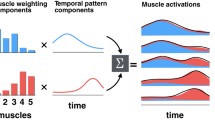Abstract
Human gait is characterized by smooth, regular and repeating movements but the control system is complex: there are many more actuators (i.e. muscles) than degrees of freedom in the system. Statistical pattern-recognition techniques have been applied to examine muscle activity signals, but these have all concentrated exclusively on unilateral gait. We report here the application of factor analysis to the electromyographic patterns of 16 muscles (eight bilateral pairs) in ten normal subjects. Consistent with our prior work, we have established two factors, named loading response and propulsion, which correspond with important phases in the gait cycle. In addition, we have also discovered a third factor, which we have named the coordinating factor, that maintains the phase shift between the left and right sides. These findings suggest that the central nervous system solves the problem of high dimensionality by generating a few fundamental signals which control the major muscle groups in both legs.
Similar content being viewed by others
References
Arsenault AB, Winter DA, Wells R (1986) Bilateralism of EMG profiles in human locomotion. Am J Phys Med 65:1–16
Basilevsky A (1994) Statistical factor analysis and related methods. Wiley, New York
Davis BL, Vaughan CL (1993) Phasic behavior of EMG signals during gait: use of multivariate statistics. J Electromyogr Kinesiol 3:51–60
Gorsuch RL (1974) Factor analysis. Saunders, Philadelphia
Grillner S, Wallen P, Brodin L, Lansner A (1991) Neuronal network generating locomotor behavior in lamprey: circuitry, transmitters, membrane properties and simulation of central pattern generators for locomotion, with special reference to vertebrates. Annu Rev Neurosci 14:169–200
Heller BW, Veltink PH, Rijkhoff NJM, Rutten WLC, Andrews BJ (1993) Reconstructing muscle activation during normal walking: a comparison of symbolic and connectionist machine learning techniques. Biol Cybern 69:327–335
Hershler C, Milner M (1978) An optimality criterion for processing electromyographic (EMG) signals relating to human locomotion. IEEE Trans Biomed Eng 25:413–420
Kadaba MP, Ramakrishnan HK, Wootten ME, Gainey J, Gorton G, Cochran GVB (1989) Repeatability of kinematic, kinetic, and electromyographic data in normal adult gait. J Orthop Res 7:849–860
Loeb GE (1989) Neural control of locomotion: how do all the data fit together? Bioscience 39: 800–804
Loeb GE, Levine WS, He J (1990) Understanding sensorimotor feedback through optimal control. Cold Spring Harbor Symp Quant Biol LV:791–803
Ounpuu S, Winter D (1989) Bilateral electromyographical analysis of the lower limbs during walking in normal adults. Electroencephalogr Clin Neurophysiol 72:429–438
Patla AE (1985) Some characteristics of EMG patterns during locomotion: implications for the locomotor control process. J Motor Behav 17:443–461
Perret C (1980) Neural origin of rhythmic movement. Cambridge University Press, Cambridge, pp 405–422
Rummel RJ (1970) Applied factor analysis. Northwestern University Press, Evanston
Sepulveda F, Wells D, Vaughan CL (1993) A neural network representation of electromyography and joint dynamics in human gait. J Biomech 26:101–109
Shiavi R, Griffin P (1981) Representing and clustering electromyographic gait patterns with multivariate techniques. Med Biol Eng Comput 19:605–611
Vaughan CL, Davis BL, O'Connor JC (1992) Dynamics of human gait. Human Kinetics, Champaign
Vaughan CL, Brooking GD, Olree KS (1995) Exploring new strategies for controlling multiple muscles in human locomotion. In: Human motion analysis: current applications and future directions. IEEE Press
Wootten ME, Kadaba MP, Cochran GVB (1990) Dynamic electromyography I. Numerical representation using principal component analysis. J Orthop Res 8:247–258
Yang JF, Winter DA (1984) Electromyographic amplitude normalization methods: improving their sensitivity as diagnostic tools in gait analysis. Arch Phys Med Rehabil 65:517–521
Author information
Authors and Affiliations
Rights and permissions
About this article
Cite this article
Olree, K.S., Vaughan, C.L. Fundamental patterns of bilateral muscle activity in human locomotion. Biol. Cybern. 73, 409–414 (1995). https://doi.org/10.1007/BF00201475
Received:
Accepted:
Issue Date:
DOI: https://doi.org/10.1007/BF00201475




